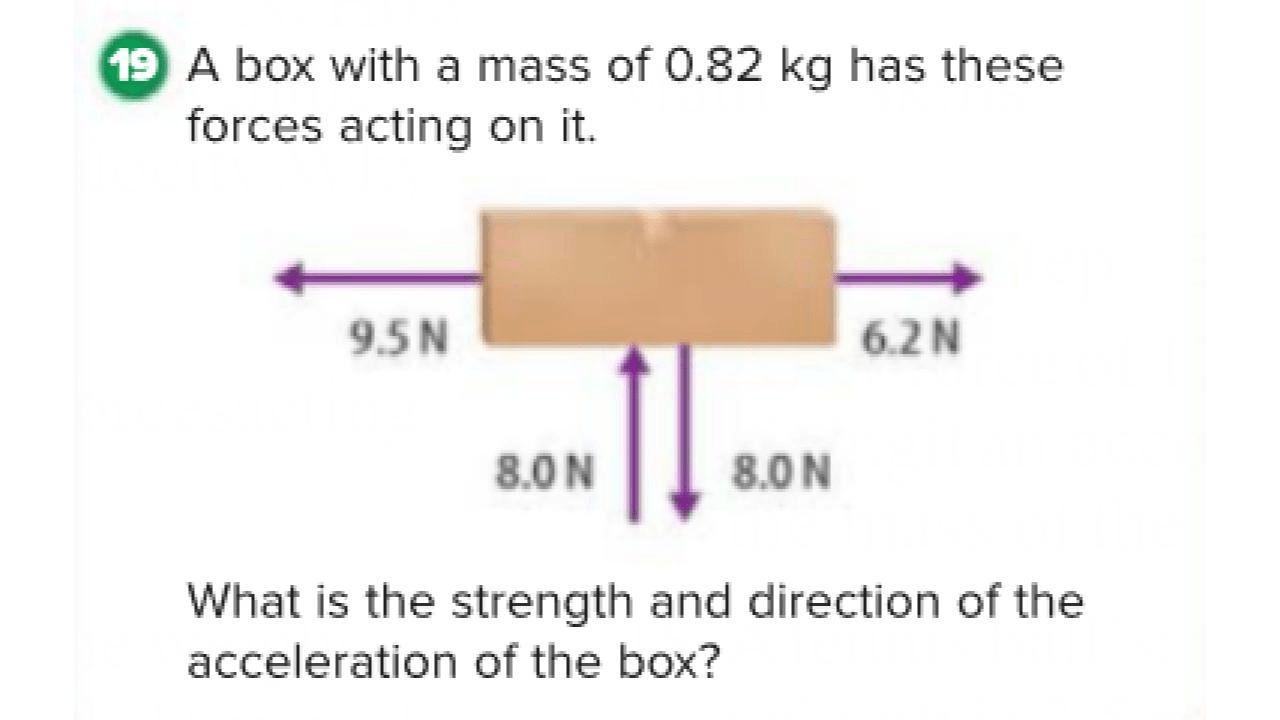What is a unit we use to measure distance in science?
meters, kilometers
What is the equation for velocity?
V=d/t
Velocity=distance/time
What is the difference between speed and velocity?
Velocity has a direction.
What is the equation to figure out force?
F=ma
force=mass X acceleration
Newton's Third Law states...
Every action has an equal and opposite reaction. Two objects exert equal force on each other.
What is the definition of a hypothesis?
A possible explanation of an observation that can be tested in science
What is the equation for figuring out time?
t=d/v
time=distance/velocity
What are the three ways an object can accelerate?
Speeding up, slowing down, and changing direction
What is the equation we use to figure out acceleration?
a=F/m
acceleration=force/mass
Newton's First Law states...
Objects in motion stay in motion, and objects at rest stay at rest unless acted on by an outside force
Describe the difference between instantaneous speed and average speed
Instantaneous speed- speed in an exact moment
Average- Speed over the course of the whole journey
How many meters is 8.73 km?
8730 m
A car travels 250 km, and the entire trip takes 5 hours. What is the average speed of the car?
50 km/h
What is the scientific word we use when something is slowing down?
Accelerating
A 30kg TV sits on a table, and the acceleration due to gravity is 9.8 m/s2. What force is the TV exerting on the table?
294 N
Newton's Second Law states...
F=ma
OR
Larger things/things accelerating faster have more force
How many millimeters are in a meter?
1,000
Convert the following number into scientific notation:
0.0000000000005324
5.324X10-13 OR 0.5324X10-12
A model train is traveling at 0.15m/s for 122 seconds. How far did it travel?
18.3m
What is a reference point we could use to say that the TV is moving?
AWV
The Sun
The Moon
A distant Star
A net force of 17N is applied to an object, giving it an acceleration of 2.5 m/s2. What is the mass of the object?
6.8 kg
What do the laws of universal gravitation tell us about how gravity changes with size and distance?
Larger things have a larger gravitational pull.
Things closer together have a larger gravitational pull.
Explain why reference points are important when describing motion
Because how the thing is moving depends on the reference point. For example, the TV is not moving in reference to the wall, but it is moving in reference to the sun.
What is a scientific theory? (use detail, you can't answer this with 2 words!)
An explanation of observed natural phenomena
Which has the greatest average speed?
A boat sailing 80km in 2 hours
A car driving 90km in 3 hours
A train traveling 120km in 3 hours
A truck moving 50km in 1 hour
The truck at 50km/hr
A ruler is on the table with the higher numbers to the right. An ant crawls along the ruler from 6cm to 2cm in 2 seconds. What is the ant's distance, speed, and velocity?
Distance: 4cm
Speed: 2 cm/s
Velocity: 2 cm/s to the left

Round to the nearest tenth
4 m/s2
The mass of a person on Earth is 72kg. What is the mass of the same person on the moon, where gravity is 1/6 that of Earth?
72kg, mass is how much stuff something is made of. WEIGHT is what is effected by gravity.
A pitcher releases a fastball that moves toward home plate. Other than the force exerted by the pitcher, what are two forces that act on the ball as it travels between the pitcher and home plate? How does each of these forces change the ball's motion?
Friction - The air around the ball causes the ball to slow down
Gravity - As the ball flies through the air, it is being pulled back down to earth by the non-contact force of gravity